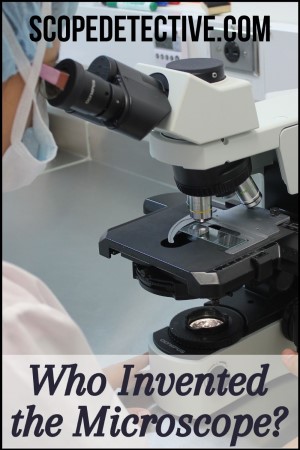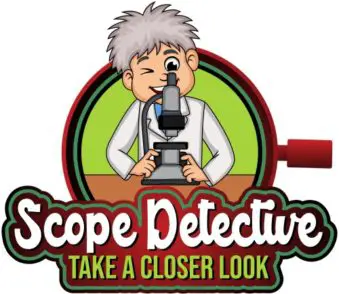 There is debate over who invented the microscope. But we know that the first compound microscope was developed in a town called Middelburg in about 1590.
There is debate over who invented the microscope. But we know that the first compound microscope was developed in a town called Middelburg in about 1590.
The confusion comes from the fact there are two competing claims to the invention of the first microscope. These claims come from two neighboring spectacle makers who were both experimenting with lens technologies at the time: Lippershey and Jansen.
> This article is from my series on the History of Microscopy
The Invention of the Microscope
1. The Lippershey Claim
The first claim comes from Hans Lippershey who is widely credited with inventing the first ever telescope. His experiments with lens magnification may have caused him to invent the microscope and telescope around the same time.
Lippershey filed patents for the microscope and telescope in 1608, placing him as the ‘official’ inventor of the telescope and compound microscope. It wasn’t for another 35 years that people would begin to question his authority over this claim.
Legend has it that Lippershey observed two children in his spectacle shop placing two spectacles over one another and remarking that it made a weather vane look much closer than it truly was. This may have led Lippershey to start experimenting with telescopy and microscopy.
Another story states Lippershey’s apprentice came up with the designs, but as was custom of the day, Lippershey laid claim to the inventions himself.
Nevertheless, what was amazing about Lippershey’s work was that he managed to use two separate lenses to effectively multiply the magnification of each, creating better magnification than the spectacles he was used to working with.
Lippershey’s invention came to be known as the “Dutch perspective glass” which likely had just 3x magnification.
2. The Janssen Claim
A competing claim states the microscope was invented by a rival spectacle make named Zacharias Janssen.
When Dutch diplomat Willem Boreel investigated to get to the bottom of the matter in 1655, he spoke with Janssen’s son, Johannes Zachariassen, who had inherited the business after his father had died.
The son, Johannes Zachariassen, testified under oath that Lippershey had in fact stolen his father’s designs. Some word of mouth testimony from locals appears to have corroborated this story, leading Boreel to declare the father, Zacharias Jansen, the inventor of the microscope.
However, Boreel was a known childhood friend of Johannes Zachariassen, which may have clouded his judgement.
Nevertheless, subsequent investigations also found that Janssen’s claim was strongest. Jean Henri van Swinden conducted an investigation in the 1820s and found Janssen to be the most likely founder of the microscope. In 1841, a prominent collector named Zacharias Snijder found in his possession a rudimentary telescope which was found to have been a prototype developed by Janssen.
3. Flaws in the Janssen Claim
There is further evidence that might reveal that Johannes Zachariassen regularly fabricated stories to gain fame and attention.
The timeline of events set out by Johannes Zachariassen would have placed his father’s age during the invention of the microscope at around 3-5 years. There is therefore speculation that it was in fact the grandfather, Hans Martens, who invented the microscope, and Johannes’s memory was simply flawed.
But subsequently, Johannes had noted his father had invented the telescope and microscope at different times – 1590 and 1604.
Johannes Zachariassen also laid claim to the Keplerian telescope (which uses two positive lenses) in 1618 and states that in 1620 the Drebbel brothers bought a telescope off his father, copied it, and claimed it as their own.
There is also speculation that Janssen was not even a spectacle maker until as late as 1615, as this was the first written record of his spectacle maker shop.
Johannes Zachariassen was also a well-known criminal who counterfeited coins. He escaped the law twice – one time by fleeing to a neighboring village, and the other time by being pardoned for possessing counterfeiting tools (a crime that would have sentenced him to death).
4. It wasn’t Galileo Galilei
One of the most common misconceptions is that Galileo Galilei invented the microscope and telescope.
Galileo never made claim to inventing either the telescope or microscope. Rather, he refined the inventions of others. The patent of Lippershey from 1608 spread throughout Europe, leading many to try to refine and replicate his work.
By 1609 Galileo had created a microscope that was simply a reverse telescope. It contained a convex objective and a concave eyepiece to achieve up to 30x magnification.
Galileo continued to refine his devices, and by 1624 had created an “occhiolino” with three bi-convex lenses. This occhiolino was later dubbed the microscope by Giovanni Faber.
5. It wasn’t Van Leeuwenhoek
Another common misconception is that Van Leeuwenhoek invented the microscope. This comes from the fact that we call van Leeuwenhoek the “father of microscopy”. But, the reason for that is that he was the most influential early microscopist who was able to make some major advancements in microscopy, including his early observations of bacteria, blood cells and muscle tissue.
But Van Leeuwenhoek was born 40 years after the microscope was invented, and in fact his microscopes were peculiar ones. They were not even compound microscopes, but with his excellent glass making skills, he managed to devise microscopes that achieved up to 200x magnification with a single glass pearl lens. He achieved this by making tiny lenses – smaller than any before them.
Conclusion
In all, it appears certain that we will never know who the true inventor of the first microscope really was. While Johannes Zachariassen has successfully convinced many investigators that it’s likely his father (or grandfather) was the inventor of the first microscope, there are also some holes in his story that remain unanswered. It would seem to me that the father, Zacharias Janssen, would (or should) have come forth to challenge Lippershey’s patent filing in 1608 in order to clarify the claim at that time.
Nevertheless, it’s a good story.
Bibliography
[2] https://fampeople.com/cat-zacharias-janssen
[3] https://www.cmog.org/article/quest-see-more-glass-lenses
Hi, I’m Chris and I run things around here! I share all my microscopy experiments, microscope information and tricks, how to guides, and microscope reviews in the articles on this site. Browse around to see what you like (I recommend the experiment ideas section) or connect with me on any of the social platforms listed below.

